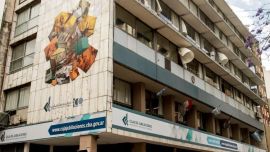Mendoza, widely acclaimed for its picturesque vineyards and prized Malbec wines, is pushing to be a leader on another front: the integration of Uber and other transportation apps.
In contrast to in Buenos Aires City – where the firm has faced lengthy legal battles and ongoing protests from taxi-drivers, despite the establishment of a loyal customer base – Uber has been given the red carpet treatment in Mendoza, which became the first province to legally allow its operation.
The company worked closely with the provincial government as a series of laws meant to regulate the sector were passed, opening the doors for Uber’s smooth integration into one of Argentina’s top tourist destinations.
“In terms of public adoption, I think Buenos Aires [City] is a clear case of success. In terms of [legal] regulations, I think it’s just the appetite that each government has for regulating something new,” said Juan Labaqui, Uber’s Head of Communications in the Southern Cone.
“In that regard, the Mendoza [provincial] government was very clear in having the political will to regulate and make sure that this was something open to all companies willing to do something about mobility and applications in the country.”
In July 2018, Mendoza’s Senate voted 24-14 to pass legislation that would allow ridehailing services to operate in the region. Uber launched fully in November with notable anticipation.
“The excitement was there for a long time,” said Labaqui. “When the bill was introduced, we had around 8,000 people potentially interested in driving. By the time the law was passed, there were close to 11,000. The excitement grew as the discussion progressed. The same goes for people riding with Uber.”
However, despite the optimism, take-up has been somehat slow.
‘YOUR TRIP STARTS HERE’
In Mendoza airport, a large banner hangs in the arrivals hall. “Your trip starts here,” it says, beneath Uber’s logo in simple white lettering.
But once the app is started, all it shows is a lone car trundling along a street downtown, Any request for a ride times out several minutes later. In the face of such excitement and demand, it seems that Uber hasn’t yet been unable to recruit enough drivers.
“With drivers, we started from zero. With riders, you’re not starting from zero because some people have already used [Uber] in other places. The demand outmatches the supply by a lot,” admits Labaqui.
Another issue contributing to the imbalance is the slew of challenges that face hopeful Uber drivers in Argentina.
“You have to put a lot of your own capital into buying and maintaining a car,” said Juan Carlos Morales, who began driving after his retirement, and now logs up to seven hours each day. “A lot of people don’t have that capital, and if they do, they don’t want to put it into Uber. There are a lot of expenses.”
Uber requires that drivers’ personal cars be 2013 models or newer, and in “excellent physical and mechanical condition.” While this hasn’t hindered Morales, he did acknowledge that other potential drivers have been deterred, for financial reasons, by the terms and conditions.
Labaqui said over 250 drivers are currently registered in Mendoza but declined to comment on the number of those drivers that are active everyday. As for riders, the Uber official remained tight-lipped.
Many riders opt for Uber due to convenience and price. In Mendoza, that’s no different.
“Nowadays, Uber is getting more popular because there are certain things taxis and remises have to do that Uber drivers don’t. For example, taxi-drivers have a starting point of 38 pesos, plus the rate per kilometre,” said Morales.
He explained that a 20-minute trip would cost a minimum of 600 pesos in a taxi, but only around 250 in an Uber.
“The people recognise the difference – in price, in quality of service,” he added.
But if people really do prefer Uber to cabs, the taxi-drivers in Mendoza have yet to feel the effects.
“Uber hasn’t affected us at all,” said Mendoza resident Roman Jure, who has driven a cab for over five years. “In Buenos Aires, there are many problems between taxis and Ubers. Not here. We don’t feel Uber’s presence here.”
Jure echoed the sentiments of those registered to drive for Uber in Mendoza.
“[Mendoza] is a big city with very few cars, and for Uber, you have to own your car, put in all the money yourself, and make sure it stays new. No-one wants to do that,” said Jure. “There’s little work for Uber here in Mendoza.”
Labaqui said that even as they grow in the province, Uber does not aim to disrupt taxi operations. “In all cases where Uber is present, the taxi has continued to be a very much present option for mobility,” he said. “Everyone thinks that because Uber launches in a cit y, t a x i s a r e suddenly going to be impacted.”
Labaqui says that’s not the case. “What Uber does is pick up on unmet demand, in places where typically someone else was not providing a service – either because it’s farther away, or taxis don’t get there, or there’s just not a reliable alternative for mobility.”
THE ROAD AHEAD
Uber is also taking steps to counteract the difficulty of becoming an Uber driver in Argentina.
“We have partners at car dealerships in Mendoza who offer special discounts and special financing programmes to people who want to drive with Uber. We typically try to do so, especially in cases like this where you have a big base of people who are interested but as the same time, the regulation pushes for clear specifications on cars,” Labaqui said.
In Buenos Aires, supply and demand is much less of an issue. When Uber landed in the city in 2016, it gained 12,000 users in just 36 hours and achieved significant recruitment success. According to Reuters, Uber claimed to have 55,000 active drivers and one million active users in Buenos Aires in 2018, with a few hundred new drivers being added every day.
Both the City’s Judiciar y and the country’s Supreme Court recently ruled in favour of Uber’s right to operate, sparking yet another wave of protests in mid-April. In a press release, taxi-drivers’ unions accused Uber of “three years of illegal and predatory activity” in Argentina.
Still, Labaqui remains hopeful about Uber’s cooperation with the Buenos Aires City government – and for future expansion.
“We are very much open, and have been since day one, to discussing regulations everywhere in the country,” he said. “We think regulations are a vehicle that can provide a framework for cooperation with cities.


























Comments